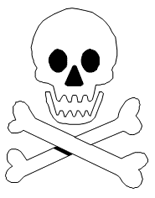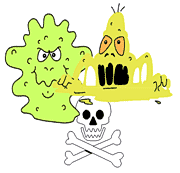Since the existence of man, he has used natural objects as tools to assist him in performing tasks he alone was not capable of doing e.g. a stone to crush a hard seed or a branch of a tree to dislodge a large rock. This practice allowed man to do much more in a much shorter period of time.
 At the same time, however, man also discovered that working with these tools could cause injury and even death. Some practices caused disease due to the material that was handled or the environment where the work was undertaken. In his book “River God”, Wilbur Smith describes the activities of sculptors working inside a burial tomb. Many of them died as result of the clogging of their lungs, due to dust inhalation. This phenomenon was attributed to the intervention of the gods, as it could not be understood or explained.
At the same time, however, man also discovered that working with these tools could cause injury and even death. Some practices caused disease due to the material that was handled or the environment where the work was undertaken. In his book “River God”, Wilbur Smith describes the activities of sculptors working inside a burial tomb. Many of them died as result of the clogging of their lungs, due to dust inhalation. This phenomenon was attributed to the intervention of the gods, as it could not be understood or explained.
Being the resourceful being he is, man quickly learned how to minimise or avoid injury and fatalities by devising methods for using tools more safely under safer conditions. This can be seen as the beginning of basic health- and safety management.
The invention of the wheel made man mobile and new tools and operating procedures were developed to cope with the demand created by new inventions and the use thereof.
For centuries man slowly developed new tools and machines, enabling him to achieve even more than what was ever possible. In the process he used existing tools to make and develop new ones.
Certain trades were established and standards were set to promote uniformity. Safe practices became standard practices.
In society the introduction of innovations such as running water on tap and (for the time) hygienic ablution facilities contributed substantially to the health and prosperity of man in general.
Through activities such as farming and mining, man was starting to impact on the environment.
The invention of the steam engine, and the resultant “Industrial Revolution” created endless opportunities for technological advancement on all fronts. The steam engine introduced an era of demand for and advancement in the field of technology never experienced.
Many factories were established and soon Industrial cities, with the infrastructure to support industry, such as harbours, railway stations, etc., were developed. Factories needed workers and thousands of people flocked to these cities in search of a better living. Unfortunately though, the working class majority of workers were subjected to the worst possible working condition for minimal wages. Extensive abuse of cheap child labour was standard practice and many children died an early death in the name of technology.
 As new inventions were introduced to industry, little or nothing was known about how the invention would perform under working conditions. This resulted in many of them failing when submitted to working conditions, often causing injury or death to the operator, and sometimes bystanders, in the process.
As new inventions were introduced to industry, little or nothing was known about how the invention would perform under working conditions. This resulted in many of them failing when submitted to working conditions, often causing injury or death to the operator, and sometimes bystanders, in the process.
Together with poor working conditions and wages, overcrowded housing facilities with little or no public utilities like sewage and sanitation, refuse removal, etc., contributed to a very sorry state of affairs.
Unhygienic living conditions allowed diseases to spread with disastrous results. Harmful by-products from industry, like smoke, poisonous gases and toxic chemicals released back into the air and rivers, further contributed to already poor health conditions.
Technology was having a greater impact on the environment. Unfortunately the enormity of the effect that technology has on the environment was only realised much later, in some cases too late, as the effect on the environment is often not observed before substantial damage has been done to the environment. Worse still, in some cases these effects were, and still are, ignored and the environment is further exploited for the benefit of mankind.
Together with this technological advancement and the consequent misery, came the need for more effective measures to prevent injury and/or disease. It eventually dawned on employers that they had to treat employees humanely to get the best results from them.
Employers had to motivate the workforce to achieve higher levels of effectiveness, gaining their trust and cooperation in the process. One way to achieve this was to improve working and living conditions to mutually negotiated and acceptable standards.
 This process included the improvement of Health and Safety standards. Through ongoing research, Health and Safety standards have been implemented and adapted to meet industry demands.
This process included the improvement of Health and Safety standards. Through ongoing research, Health and Safety standards have been implemented and adapted to meet industry demands.
A lot of effort and money goes into the study of the effect of technological advancement on the environment. Research has shown that Industrial activity has in many cases had devastating effects on the environment. Measures to protect the environment against the negative effects of human exploitation need to be devised and adapted according to the ever changing need thereof.